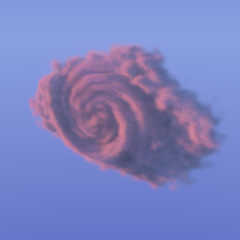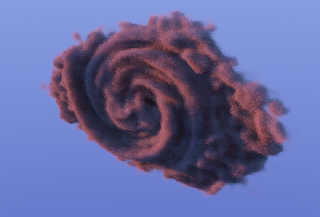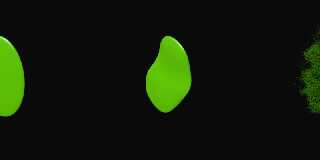 |
 |
|
 |
|
 |
|  |
|  |
|
 |
|
 |
|  |
|  |
|
 |
Using several povr features, tried my hand at rendering an isosurface
cloud this afternoon. Like media, it takes some twiddling. Using +am1
+a0.0 +r9 to force a large amount of sampling, one light for the sun and
radiosity it took about 30 minutes on my two core, four thread i3.
How many shapes - bazillions :-).
Bill P.
Post a reply to this message
Attachments:
Download 'isoclouds3.jpg' (34 KB)
Preview of image 'isoclouds3.jpg'

|
 |
|  |
|  |
|
 |
|
 |
|  |
|  |
|
 |
After Thomas' splines in isosurfaces, they are quite popular nowadays ! ;-)
Your cloud looks more like smoke to me but the idea is very interesting. Thanks
for sharing.
Pascal
William F Pokorny <ano### [at] anonymous org> wrote:
> Using several povr features, tried my hand at rendering an isosurface
> cloud this afternoon. Like media, it takes some twiddling. Using +am1
> +a0.0 +r9 to force a large amount of sampling, one light for the sun and
> radiosity it took about 30 minutes on my two core, four thread i3.
>
> How many shapes - bazillions :-).
>
> Bill P. org> wrote:
> Using several povr features, tried my hand at rendering an isosurface
> cloud this afternoon. Like media, it takes some twiddling. Using +am1
> +a0.0 +r9 to force a large amount of sampling, one light for the sun and
> radiosity it took about 30 minutes on my two core, four thread i3.
>
> How many shapes - bazillions :-).
>
> Bill P.
Post a reply to this message
|
 |
|  |
|  |
|
 |
|
 |
|  |
|  |
|
 |
On 8/18/20 6:21 AM, BayashiPascal wrote:
> After Thomas' splines in isosurfaces, they are quite popular nowadays ! ;-)
>
Yes, with povr been trying to remove some of the longstanding code
issues and functional limitations. We'll see.
> Your cloud looks more like smoke to me but the idea is very interesting. Thanks
> for sharing.
>
Yes, think you are right. The core issue is similar to what Kima has
been asking about with color depth and banding. With isosurfaces, even
forcing a lot of rays to be shot, you always have discrete shapes /
grains at locations, unlike a media density of some kind. The isosurface
jitter feature of povr helps a little with this, but it currently
jitters only 'within' the accuracy amount.
If I apply some gaussian blurring with POV-Ray or external tool, I get
something looking more cloud like, but not quite right on the fuzzy
side. I could too probably help the cloud look by using some overall
haze, but for this I wanted to better see the cloud structure. To
explore / push the technique some.
I'll attach another variant where I cranked down on the gradient and
accuracy while adding a second much smaller violent turbulence. To my
eye less cloud like still, but interesting too. Not really sure what it
looks like... Fuzzy fabric?
Aside: I reworked the fog feature in povr. Everything with it is depth
based, but I have this rough idea forming in my head we might be able to
do something interesting combining fog with isosurfaces of the fuzzy
kind - maybe where some are all of the fuzzy shapes are transparent.
Anyway, an idea for another day.
Bill P.
Post a reply to this message
Attachments:
Download 'isoclouds4.jpg' (158 KB)
Preview of image 'isoclouds4.jpg'

|
 |
|  |
|  |
|
 |
|
 |
|  |
|  |
|
 |
Op 19/08/2020 om 14:20 schreef William F Pokorny:
> On 8/18/20 6:21 AM, BayashiPascal wrote:
>> After Thomas' splines in isosurfaces, they are quite popular nowadays
>> ! ;-)
>>
> Yes, with povr been trying to remove some of the longstanding code
> issues and functional limitations. We'll see.
>
>> Your cloud looks more like smoke to me but the idea is very
>> interesting. Thanks
>> for sharing.
>>
>
> Yes, think you are right. The core issue is similar to what Kima has
> been asking about with color depth and banding. With isosurfaces, even
> forcing a lot of rays to be shot, you always have discrete shapes /
> grains at locations, unlike a media density of some kind. The isosurface
> jitter feature of povr helps a little with this, but it currently
> jitters only 'within' the accuracy amount.
>
> If I apply some gaussian blurring with POV-Ray or external tool, I get
> something looking more cloud like, but not quite right on the fuzzy
> side. I could too probably help the cloud look by using some overall
> haze, but for this I wanted to better see the cloud structure. To
> explore / push the technique some.
>
> I'll attach another variant where I cranked down on the gradient and
> accuracy while adding a second much smaller violent turbulence. To my
> eye less cloud like still, but interesting too. Not really sure what it
> looks like... Fuzzy fabric?
>
> Aside: I reworked the fog feature in povr. Everything with it is depth
> based, but I have this rough idea forming in my head we might be able to
> do something interesting combining fog with isosurfaces of the fuzzy
> kind - maybe where some are all of the fuzzy shapes are transparent.
> Anyway, an idea for another day.
>
> Bill P.
>
Interesting work! not really cloud-like perhaps, and second one looks
very much like a soft fluffy pillow, but this could lead to many uses.
Intrigued by your fog ideas by the way... reminds me of the ghostly
df3-with-media experiments from a couple of years ago.
--
Thomas
Post a reply to this message
|
 |
|  |
|  |
|
 |
|
 |
|  |
|  |
|
 |
William F Pokorny <ano### [at] anonymous org> wrote:
> Using several povr features, tried my hand at rendering an isosurface
> cloud this afternoon. Like media, it takes some twiddling...
>
> How many shapes - bazillions :-).
>
I really like your first image; it reminds me of the 'whimsical clouds' in the
live-action movie version of HOW THE GRINCH STOLE CHRISTMAS (with Jim Carrey). I
have no idea how you achieved the fuzzy media-like look, using an isosurface,
but it looks great. org> wrote:
> Using several povr features, tried my hand at rendering an isosurface
> cloud this afternoon. Like media, it takes some twiddling...
>
> How many shapes - bazillions :-).
>
I really like your first image; it reminds me of the 'whimsical clouds' in the
live-action movie version of HOW THE GRINCH STOLE CHRISTMAS (with Jim Carrey). I
have no idea how you achieved the fuzzy media-like look, using an isosurface,
but it looks great.
Post a reply to this message
|
 |
|  |
|  |
|
 |
|
 |
|  |
|  |
|
 |
On 9/2/20 2:21 PM, Kenneth wrote:
> William F Pokorny <ano### [at] anonymous org> wrote:
...
>
> I really like your first image; it reminds me of the 'whimsical clouds' in the
> live-action movie version of HOW THE GRINCH STOLE CHRISTMAS (with Jim Carrey). I
> have no idea how you achieved the fuzzy media-like look, using an isosurface,
> but it looks great.
>
Thank you.
Bill P. org> wrote:
...
>
> I really like your first image; it reminds me of the 'whimsical clouds' in the
> live-action movie version of HOW THE GRINCH STOLE CHRISTMAS (with Jim Carrey). I
> have no idea how you achieved the fuzzy media-like look, using an isosurface,
> but it looks great.
>
Thank you.
Bill P.
Post a reply to this message
|
 |
|  |
|  |
|
 |
|
 |
|  |
|  |
|
 |
William F Pokorny <ano### [at] anonymous org> wrote:
> Using several povr features, tried my hand at rendering an isosurface
> cloud this afternoon. Like media, it takes some twiddling. Using +am1
> +a0.0 +r9 to force a large amount of sampling, one light for the sun and
> radiosity it took about 30 minutes on my two core, four thread i3.
>
> How many shapes - bazillions :-).
>
> Bill P.
I browse here at the first time.
It is good, how do you render such an image with a "surface"? org> wrote:
> Using several povr features, tried my hand at rendering an isosurface
> cloud this afternoon. Like media, it takes some twiddling. Using +am1
> +a0.0 +r9 to force a large amount of sampling, one light for the sun and
> radiosity it took about 30 minutes on my two core, four thread i3.
>
> How many shapes - bazillions :-).
>
> Bill P.
I browse here at the first time.
It is good, how do you render such an image with a "surface"?
Post a reply to this message
|
 |
|  |
|  |
|
 |
|
 |
|  |
|  |
|
 |
On 9/4/23 04:28, And wrote:
> William F Pokorny <ano### [at] anonymous org> wrote:
>> Using several povr features, tried my hand at rendering an isosurface
>> cloud this afternoon. Like media, it takes some twiddling. Using +am1
>> +a0.0 +r9 to force a large amount of sampling, one light for the sun and
>> radiosity it took about 30 minutes on my two core, four thread i3.
>>
>> How many shapes - bazillions :-).
>>
>> Bill P.
>
> I browse here at the first time.
> It is good, how do you render such an image with a "surface"?
>
Hi. I've attached an image and will paste in the POV-Ray (povr) scene
file used to create the sub-images. Your question gives me a chance to
show povr's 'pattern_modifiers' feature too!
On the left is the f_sphere() modified, but still with no turbulence.
The center image applied a gentle warp { turbulence ...}.
Your question is answered with the image on the right where a violent
warp turbulence was applied; one which blows the isosurface apart.
The max gradient jumps way up - but we'd ignore it (povr's isosurface
'report off') in any more complex scene. The max_gradient you use
becomes a particle sampling setting. For a cloud, or bush, or tree
foliage you want the isosurface to act like a collection of particles.
Bill P.
//-------------------------------- isoCloudsExmpl.pov
#version unofficial 3.8; // povr
#if (file_exists("version.inc"))
#include "version.inc"
#end
#if (!defined(Fork_povr))
#error "This POV-Ray SDL code requires the povr fork."
#end
global_settings { assumed_gamma 1 }
#declare Grey10 = srgb <0.1,0.1,0.1>;
background { Grey10*0.3 }
#declare Camera00 = camera {
perspective
location <3,3,-3.001>*0.7
sky y
angle 35
right x*(image_width/image_height)
look_at <0,0,0>
}
#declare White = srgb <1,1,1>;
#declare Light00 = light_source { <50,150,-250>, White }
// The focus is just below. It shows the use of the
// pattern_modifiers keyword as a way to use the spacial
// modifiers, POV-Ray users know, to manipulate inbuilt functions.
#include "functions.inc"
// Function f_sphere defined in functions.inc
// Bang on a f_sphere() function
#declare Black = srgb <0,0,0>;
#declare PigMods00 = pigment {
color Black
rotate 45*x
scale <1.3,2.3,0.2>
rotate -15*y
#if (0)
warp { turbulence <0.2,0.2,0.2>
octaves 3 omega 0.37 lambda 1.75 }
#elseif (1)
warp { turbulence <0.2,0.2,0.2>
octaves 7 omega 0.87 lambda 7.75 }
#end
}
#declare FnPigMods00 = function {
pattern_modifiers { PigMods00 }
}
#declare Fn00 = function (x,y,z) {
f_sphere(FnPigMods00(x,y,z).x,
FnPigMods00(x,y,z).y,
FnPigMods00(x,y,z).z,0.3)
}
#declare ChartreuseGreen = srgb <0.50196,1,0.05>;
#declare Isosurface00 = isosurface {
function { Fn00(x,y,z) }
contained_by { box { -1.0,1.0 } }
report on
threshold 0
accuracy 0.0005
max_gradient 17.0
max_trace 1
pigment { color ChartreuseGreen }
}
//--- scene ---
camera { Camera00 }
light_source { Light00 }
object { Isosurface00 finish { phong 0.6 phong_size 20} } org> wrote:
>> Using several povr features, tried my hand at rendering an isosurface
>> cloud this afternoon. Like media, it takes some twiddling. Using +am1
>> +a0.0 +r9 to force a large amount of sampling, one light for the sun and
>> radiosity it took about 30 minutes on my two core, four thread i3.
>>
>> How many shapes - bazillions :-).
>>
>> Bill P.
>
> I browse here at the first time.
> It is good, how do you render such an image with a "surface"?
>
Hi. I've attached an image and will paste in the POV-Ray (povr) scene
file used to create the sub-images. Your question gives me a chance to
show povr's 'pattern_modifiers' feature too!
On the left is the f_sphere() modified, but still with no turbulence.
The center image applied a gentle warp { turbulence ...}.
Your question is answered with the image on the right where a violent
warp turbulence was applied; one which blows the isosurface apart.
The max gradient jumps way up - but we'd ignore it (povr's isosurface
'report off') in any more complex scene. The max_gradient you use
becomes a particle sampling setting. For a cloud, or bush, or tree
foliage you want the isosurface to act like a collection of particles.
Bill P.
//-------------------------------- isoCloudsExmpl.pov
#version unofficial 3.8; // povr
#if (file_exists("version.inc"))
#include "version.inc"
#end
#if (!defined(Fork_povr))
#error "This POV-Ray SDL code requires the povr fork."
#end
global_settings { assumed_gamma 1 }
#declare Grey10 = srgb <0.1,0.1,0.1>;
background { Grey10*0.3 }
#declare Camera00 = camera {
perspective
location <3,3,-3.001>*0.7
sky y
angle 35
right x*(image_width/image_height)
look_at <0,0,0>
}
#declare White = srgb <1,1,1>;
#declare Light00 = light_source { <50,150,-250>, White }
// The focus is just below. It shows the use of the
// pattern_modifiers keyword as a way to use the spacial
// modifiers, POV-Ray users know, to manipulate inbuilt functions.
#include "functions.inc"
// Function f_sphere defined in functions.inc
// Bang on a f_sphere() function
#declare Black = srgb <0,0,0>;
#declare PigMods00 = pigment {
color Black
rotate 45*x
scale <1.3,2.3,0.2>
rotate -15*y
#if (0)
warp { turbulence <0.2,0.2,0.2>
octaves 3 omega 0.37 lambda 1.75 }
#elseif (1)
warp { turbulence <0.2,0.2,0.2>
octaves 7 omega 0.87 lambda 7.75 }
#end
}
#declare FnPigMods00 = function {
pattern_modifiers { PigMods00 }
}
#declare Fn00 = function (x,y,z) {
f_sphere(FnPigMods00(x,y,z).x,
FnPigMods00(x,y,z).y,
FnPigMods00(x,y,z).z,0.3)
}
#declare ChartreuseGreen = srgb <0.50196,1,0.05>;
#declare Isosurface00 = isosurface {
function { Fn00(x,y,z) }
contained_by { box { -1.0,1.0 } }
report on
threshold 0
accuracy 0.0005
max_gradient 17.0
max_trace 1
pigment { color ChartreuseGreen }
}
//--- scene ---
camera { Camera00 }
light_source { Light00 }
object { Isosurface00 finish { phong 0.6 phong_size 20} }
Post a reply to this message
Attachments:
Download 'isocloudsexmpl.png' (81 KB)
Preview of image 'isocloudsexmpl.png'

|
 |
|  |
|  |
|
 |
|
 |
|  |
|  |
|
 |
I see! It is a new branch of POV-Ray.
Because I read/write English strenuous, I seldom look at another threads.
I notice if it has the ability to deal with micro-bumps/ micro normal effect? I
knows that an undulate surface can hide part of their area sometimes.
I think it is important.
Post a reply to this message
|
 |
|  |
|  |
|
 |
|
 |
|  |
|
 |




![]()